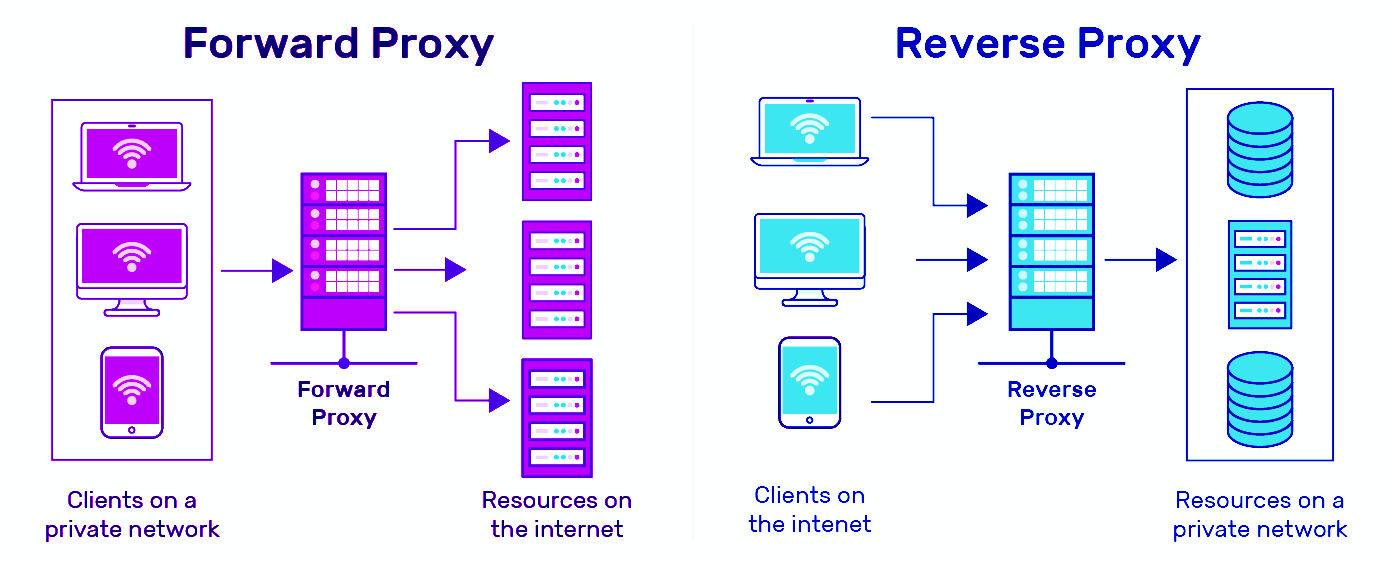Introduction to Reverse Proxy Servers
A reverse proxy server functions as an intermediary that stands between client devices (such as web browsers) and web servers, channeling client requests to the intended web servers. Predominantly utilized for enhancing security measures, optimizing performance, and ensuring reliability, reverse proxies have become an integral part of modern web architecture. To appreciate the utility and benefits of a reverse proxy server, one must first comprehend the basic mechanics of a proxy server.
Deciphering the Proxy Server
Typically referred to as a forward proxy, a proxy server resides between a cluster of client machines and the internet at large. This server intercepts client-generated requests, acting as a liaison to relay those requests to web servers. It serves as a middle entity in the communication process.

Forward Proxy Communication Model
In a traditional forward proxy setup, consider the following entities:
- Computer A: Represents the home computer of a user.
- Computer B: Symbolizes the forward proxy server.
- Computer C: Denotes the origin server where the website data resides.
Data Flow in Forward Proxy
The data traffic progresses in the following manner:
- User’s Device (A) -> Forward Proxy (B) -> Internet -> Origin Server (C)
In a vanilla internet communication framework, Computer A directly interacts with Computer C. When a forward proxy is inserted into this equation, all client requests from Computer A are redirected to Computer B, which subsequently forwards them to Computer C.
Benefits of Using a Forward Proxy
Implementing a forward proxy can serve multiple purposes:
- Circumventing Geo-Restrictions: Enables users to access a filtered or restricted version of the internet by bypassing state or institutional firewalls.
- Content Filtering: Administrators can prevent user access to specific types of web content.
- Anonymity and Security: Users can obscure their original IP address, making it challenging to trace their activities back to them.
Differentiating Between Forward and Reverse Proxies
Whereas a forward proxy serves as a go-between for client devices, a reverse proxy focuses on representing one or multiple web servers. In this setup, the reverse proxy server intercepts client requests before they reach the origin server.
Reverse Proxy Communication Model
In this context, the entities involved are:
- Computer D: Represents multiple user’s home computers.
- Computer E: Symbolizes the reverse proxy server.
- Computer F: Denotes one or more origin servers.
Data Flow in Reverse Proxy
The traffic flow can be described as follows:
- User’s Device (D) -> Internet -> Reverse Proxy (E) -> Origin Server (F)
In a standard framework, Computer D directly interfaces with Computer F. With a reverse proxy in place, all requests from Computer D route through Computer E, which in turn communicates with Computer F.
Advantages of Utilizing a Reverse Proxy
Implementing a reverse proxy offers numerous benefits, including but not limited to:
1. Load Balancing
- Efficiency: Distributes client requests across multiple servers to ensure none becomes overloaded.
- Redundancy: Provides backup servers in case of failure, ensuring uninterrupted service.
2. Security Enhancement
- Anonymity: Protects the origin server’s IP address, making targeted attacks difficult.
- Advanced Security: A reverse proxy like Cloudflare’s CDN offers better defense mechanisms against cyberattacks like DDoS.
3. Global Server Load Balancing (GSLB)
- Proximity-Based Routing: Directs clients to the geographically closest server, reducing latency.
- Optimized Experience: Ensures that global users get the best possible browsing experience.
4. Caching Capabilities
- Speed: Stores content closer to the user, reducing load times.
- Resource Optimization: Reduces the load on origin servers by serving cached content.
5. SSL Encryption
- Resource Allocation: Manages SSL encryption and decryption, freeing up server resources.
- Enhanced Security: Offers an additional layer of encryption for data in transit.
Implementing a Reverse Proxy
Developing an in-house reverse proxy can be resource-intensive and costly, involving considerable hardware and software investments.
By understanding the nuanced differences and advantages of forward and reverse proxies, organizations can make informed decisions on implementing these technologies to enhance security, optimize performance, and ensure high availability.




